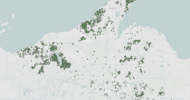
A new study suggests the effects of large-scale land acquisitions are detrimental to food security and the livelihood of smallholder farmers. (Photo: Shutterstock)
Large-scale land acquisitions in Africa: is bigger really better?
By Petra Loho
The 2007-2008 global food crises, caused by escalating oil prices; a greater request for biofuels and trade decisions, triggered an increased demand for fertile land and has resulted in internationally listed companies, investment funds and private investors entering into large-scale land acquisition deals – particularly in Africa.
According to Land Matrix, an independent land monitoring initiative, the continent accounts for 34% of the globally acquired land for agricultural purposes. Politics has propagated large-scale land acquisitions as a vital strategy for Africa’s rural development and modernising the continent’s agricultural sector. However, the study Effects of large-scale acquisitions in Africa on selected economic and social indicators published in April 2021 revealed only 11% of the area under contract in these deals is farmed. Individual large-scale land acquisition farms comprise more than 200 hectares.
MISEREOR, a not-for-profit organisation fighting poverty in Africa, Asia and Latin America, commissioned the research paper, conducted by two German scientists. MISEROR consultant Sabine Dorlöchter-Sulser said the labour intensity in small-holder farms is significantly higher than in lightly or highly mechanised large farms.
“Large farms mainly need seasonal workers and create few permanent jobs. There is a release of workers due to large-scale land purchases,” she said, indicating their calculations reflected a negative employment rate between 22% and 74%.
The study also showed many of the crops produced on these farms were for non-food purposes and larger farms generally achieved lower productivity per hectare than smaller ones. Although more external resources were used, large-scale farms did not achieve higher area yields than small-scale farms.
“The narrative ‘the bigger, the better’ doesn’t stand up to the reality check,” she said.
Luís Muchanga, director of the Mozambican Farmers Association (União Nacional dos Camponeses), agrees.
“On the one hand, you have big capital; on the other, we have communities fighting for survival. Both want land; both need the land,” he told the Global Forum for Food and Agriculture (GFFA) 2022 expert panel during the conference held in Berlin in January.
Land Matrix states in Mozambique about 1.92 million hectares of land was acquired with signed contracts, mainly for wood and fibre production (48.7%) followed by forestry (8.7%) and food crop production (8.4%).
The Mozambican agricultural sector consists mainly of small-scale farmers working on small plots of land cultivated under rain-fed conditions. In contrast, a small number of large-scale commercial farmers use most of the irrigated land.
Muchanga said large-scale agricultural areas have been grabbed and used for other purposes like commodity production.
“These are no good when it comes to reducing poverty and hunger, let alone ensuring a dignified livelihood in our country,” he added.
Mozambique, a member of the Organisation of Islamic Cooperation (OIC) and home to over 31 million people, ranked 106 of 116 countries in the 2021 Global Hunger Index. Four out of five people can’t afford an adequate diet and 42.3% of children under five years old are stunted. Muchanga sees agroecology, sustainable farming that works with nature, as the solution, since it fosters social inclusion and ensures survival and an income for all.
“We use local seed in particular. This is the approach we want to promote to step up plant and crop protection at the local level,” he said about the association’s work.
Dorlöchter-Sulser said despite intense urbanisation, the African rural population would continue growing strongly in absolute terms beyond 2050.
“In the absence of other sectors to absorb this unskilled workforce, land and owning a farm will remain central to most people's livelihoods,” she said.













